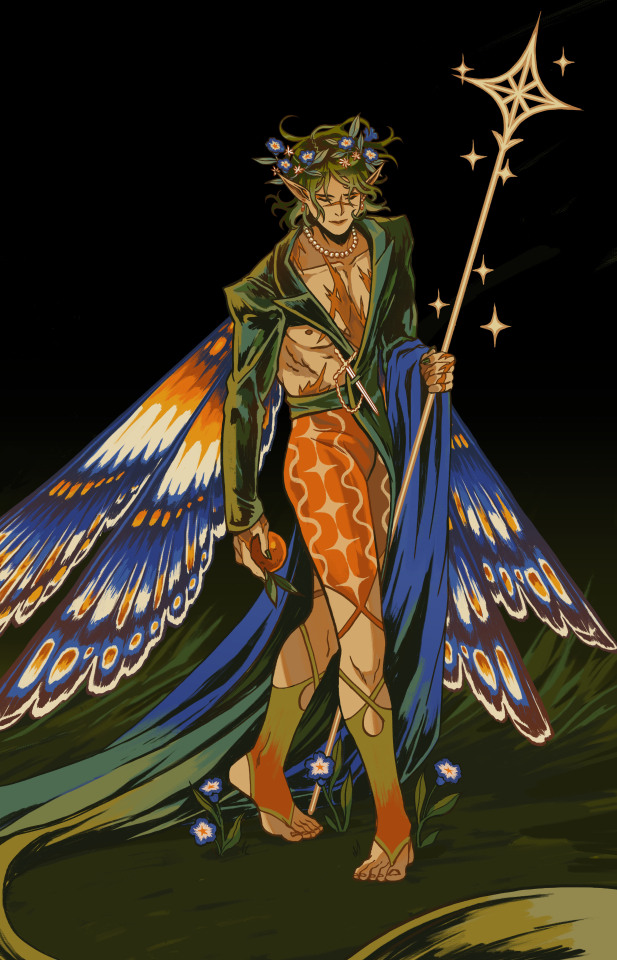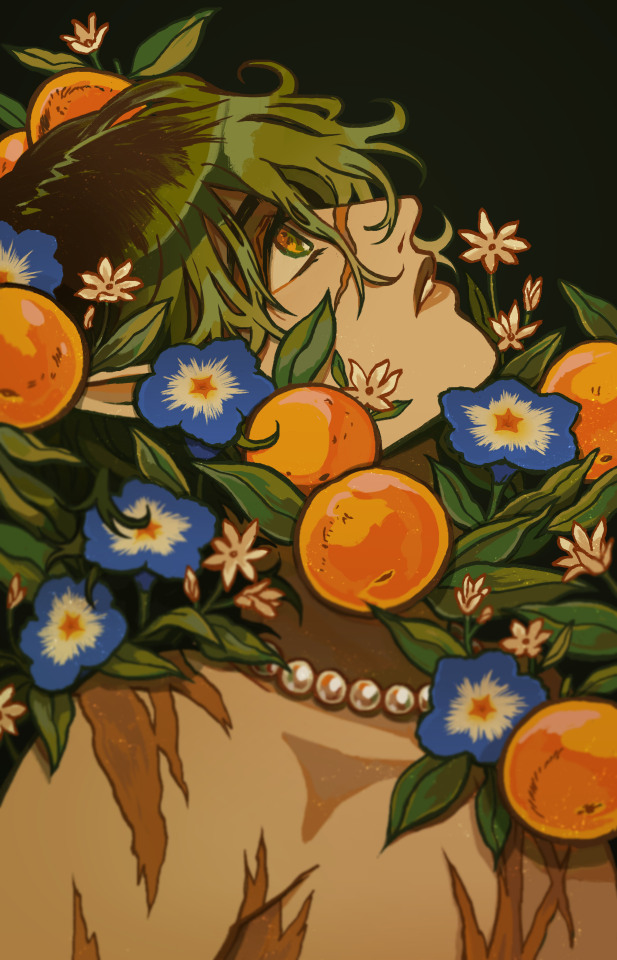A Chronological Survey of DND's Official Modules (and some contemporaries, for funsies)
Last active 60 minutes ago
Don't wanna be here? Send us removal request.
Text
🥳🥳
Celebrating coming back to ChronoTSR by forgetting to put the cut in. At some point it's just tradition!
0 notes
Text
No. 9 - T1, The Village of Hommlet (August 1979)
Author(s): Gary Gygax Artist(s): David A. Trampier (Cover), David C. Sutherland III Level range: 1 Theme: Tutorial dungeon Major re-releases: T1-4 The Temple of Elemental Evil, The Village of Hommlet (2009), Original Adventures Reincarnated #6.
CW: Discussion of Antisemitism. I didn't see that coming.
Possibly the end of the hiatus curse? Since then, I had further brainworms and acquired (and read) the fiend folio, the MM2, several Jon Petersen histories on TSR and the industry, and more. Will this reflect in the review itself? Maybe!
...Wait, there's a 4e version? 4e had a really weird habit of random 1e remakes didn't it? It was a reward for WOTC's organized play DMs, I have not read it in its entirety but it is very revisionist in a bad way. It's jarring, it mashes up 4e-style art with the original black and white pen-drawn art of 1e and also greyscale realistic maps? It's a mess of a release and there's some truly weird retcons in it. Anyway, we're here for 1e, not 4e.
Actually, one more aside. There is an adventure sequence called The Great Greyhawk Campaign. It was never officially announced or released as one product, but the idea goes that you start in Hommlet, you go to the Temple of Elemental Evil, you do the Slavelords campaign, then the Giants sequence, then the Drow sequence, and finally wrap in Q1. That's a hell of a ride, and it would probably comfortably get you to level cap for most characters. I really wanna try it some day, but I can't imagine it ever happening (that is SO long!)
So. T1. How do you start with T1?
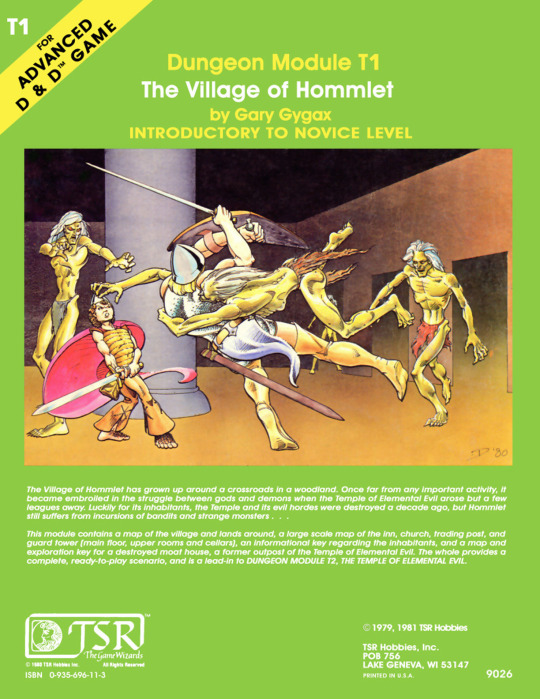
I think you can seriously argue that T1 is the single most reviewed module of all time. It honestly feels a little excessive to cover it. And yet, I felt obligated to do my dues to T1. Why?
Because T1 is, more than any previous module, the most influential module ever made. Lots of early modules are influential. G1 is important for being the first standalone module. D2 is important for being an early module to not assume hostilities. B1 is the first tutorial dungeon. But the thing about all of those is that in 2025, those types of modules have dramatically moved on. T1 remains the same. T1 is the granddaddy of all starter towns in every video game and every ttrpg. Every starter town is being compared against T1, it is the baseline.
Now this is not to say that T1 is perfect, or that T1 has aged like fine wine. But T1 tapped into something elemental about D&D that it needed to progress. Prior to T1, many parties simply...didn't play out the out-of-the-dungeon part. Characters poofed into the dungeon entrance and poofed out because the game was about dungeoncrawling. T1 represents a wildly different vision for the game, one that Gary and friends had been doing for a while and many people had independently dreamed up, but T1 made it standard that there was a nearby town that you actually went to and played things out, that was your home base. D3 was still, ultimately, a hostile environment. Like look at this:

That's just what DND towns look like. This basic structure (a town with a mayor and farmers and shopkeeps and blacksmiths and the local wizard and a dungeon nearby) is ubiquitous in DND now. You can basically describe any given dnd starting town as Hommlet And BLANK. Orlane is Hommlet And Kidnappings. Phandelin is Hommlet And Miners. Shadowdale is Hommlet And Wizards. Saltmarsh is Hommlet And Smugglers. It's hard to even get across how little has fundamentally changed between T1 and the 2014 Starter Set. Really if one thing has "changed" between T1 and then, it's the belief that adventures SHOULD have narrative hooks and SHOULD have an overarching plot. Even then they sometimes skip those.
Despite it's influence, T1 is weird in that it feels less like a module and more like a game aid. At its core, Hommlet is a town that has nothing to do with the nearby dungeon, and a dungeon that has nothing to do with the town. The town is keyed like a dungeon, and the dungeon is keyed like...a dungeon. The connective tissue is that the Temple of Elemental Evil is lurking as a threat behind everything, but T4 won't be released for QUITE some time, so it feels vague and distant. We get an actually surprisingly sophisticated history lesson: Hommlet was founded as a travel inn, a blacksmithy, and some farms. It grew into a proper town. Things got bad when their neighbors in Evil Town decided to Worship Evil and did Evil Stuff to them. The forces of good rallied and killed the bad guys, sieging the Temple of Elemental Evil and locking the evil inside. Adventurers slowly dried up as the area ran out of adventure to adventure at. So now evil returns and you lot will bumble into it.
Let us, then, get into the town part of the key.
One of the cliches of old TSR towns, to me, is that item #1 is always a farm. The game always presumes you enter town and you find a farm and the family is there and they wave at you. Orlane inverts this a bit by having the farmers NOT happy to see you, which is one of the many reasons I consider Orlane to be the most interesting starter village ever.
At this point time, thieves are a class now, and so (conspicuously) everything is marked for how the players could rob it.
There are a lot of what you might call "empty hooks" lying around town. For example, the son of a local farmer is actually a spy for Verbabonc (SUCH a TSR name) that will help you if paid to, and if he dies his brother will demand restitution. Why? That's left to a later module! Which wouldn't come out for another 6 years! Oops!
The wealth amounts in this town are genuinely unhinged, as usual. Inside a crock in some cowshit is, for some reason, nearly 700gp of treasure. Would you go digging around in cowshit for 70 dollars? Maybe if I had gloves. The placements are all nefariously difficult here: "sewn inside a horsecollar" do kids even know what horsecollars are anymore? Do they know who Horace Horsecaller is? How old are we!
A frankly annoying quality here is that these buildings are keyed with the first appearance in ALLCAPS followed by the actual building title in the body paragraph -- The Inn of the Welcome Wench is buried 3 lines into its text. You're not gonna skim that. You have to know in advance where it is, basically. The inn itself is, inexplicably, keyed separately without calling out that the actual room-by-room is elsewhere. If you scroll forward to page 9 (possibly looking for the map, which is also housed elsewhere), The contents of the inn itself is fairly ho-hum, it's a normal inn with many normal recruitment opportunity and the obligatory gygaxian traitor henchmen (who are unfailingly higher levels than their non-traitor peers). A few specialties are here though: a secret room from the old resistance, a spy from the temple of elemental evil, a secret ceiling compartment where druids can spy on suspicious guests).
A cavalcade of repetitive cottagers follow, emphasizing why in the future we stopped keying every single house. Many are not named, with that classic "so you customize it" excuse that people love trotting out. It does serve the purpose of making sure you have an answer to exactly who is with which faction: The Cuthbertites, the newbie; The Grove, part of the old alliance; the Temple, Verbabonc, the big supporter of the alliance; or one of the few neutrals.
The trader's establishment is also lovingly given a map and keys. Curiously, it is for lack of a better phrase "sub keyed", where the main room has every single item in it given a location. The map is here mainly because the players might discover the traders are also spies and want to kill them. They probably won't succeed, it's a Lv10 thief and a Lv7 assassin, they will at best cause them to flee and at worse die in the process.
I always find it funny how "moneychanger" is a perpetual occupation in DND. I have no idea how common historical moneychangers were, but if DND is to be believed, there's one in every podunk town. What do they do for the majority of the year when it's not market day?
For reasons I cannot fathom, they finally call out the separate map and key for the church after skipping every other keyed location. It's a standard fantasy church, styled after a catholic one, with the bit that Cuthbert is a brute and likes beating his worshippers into compliance. It's trying very hard to be funny but I'm not sure how funny it'd be to any table I've run. Why precisely this needed a room by room map is unclear to me, I can't foresee why you'd fight there. The walled manor is not keyed, despite being the official holdout if the temple attacks.
A half-built castle is underway for the town's old heroes, Burne and Rufus, who are mid level adventurers who have settled down. They live next door in the tower, which gets its own key, though there's not much to report beyond "it's a guard tower." Really, the main advantage of T1 as a document is that it has maps for your default buildings: a town, an inn, a trader's shop, a guard tower, and a dungeon. The maps are probably worth more than the keying for the purposes of the neophyte GM.

It is truly the town-est town ever to have town'd. Its genericity means you really could just put it in any faux medieval fantasy setting anywhere.
Nothing's really driving you to the main dungeon, that moathouse, in fact it never directs you to mention the moathouse from any specific NPC. You either work it in or the players need to wander around and explore it for simply being there -- like you're playing a TES game. In fact, not much of this book's setups really fire off anything else. There are a few people who will tail you into the dungeon or betray you if you hire them to go in with you, but that's pretty much it. All the actual secret going on in this town is immaterial to T1, setting up for T4? But let's talk about the moathouse.
First of all, I just adore the bad guy's name. "Lareth the Beautiful." They really don't make NPC names like they used to. A good title after a first name -- even just a place of origin name (Bridgette of Freeport) starts implying things about the world that are far more interesting that Jane Silvercat. A pox on noun-noun names! It's almost a shame Lareth will probably die here because he begs to be put to greater use! In any event, the Moathouse is a shithole. Just look at this mess:
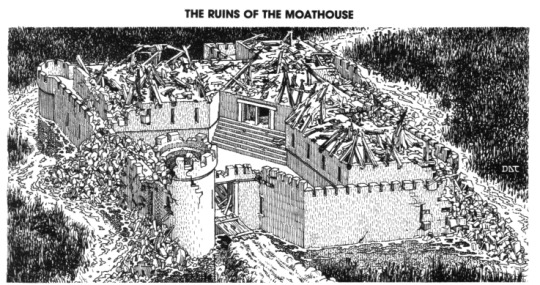
Your first instinct when you're reading about the new castle is "why don't they just repair the moathouse?" and you see this mess and you go "oh yeah that makes sense." There's not much to say: it's a moathouse the Temple of Elemental Evil built as an outpost. It got destroyed when the Temple got shut down by the big alliance, and now it's despised and destroyed. It's faintly defiled land. Really the weird thing is that it's a full hour away in a marsh. I will spare you the Monty Python bit.
Going into the keying now:
The random table is interesting in that half of the encounters are actually not encounters at all, but rather random happenings. It's a messed up castle so it's echo-y and there's rats and it's still in the process of falling down.
There's something so simple about being jumped by frogs at the front gate. I always love the "drag the player by the frog's tongue" moment and I use it often in my own games.
This dungeon is working hard to communicate how messed up it is. Even the floor will give in on your mount, laming them. Mercifully, there's a chance of discovering bootprints to confirm you're not alone.
The bandits inside have a solid escape plan, and will use it if you look scary: bar the door and run through the hole in the wall into the marsh. It's nice to see clever bandits sometimes.
Not unlike Saltmarsh later, the top level is mostly deserted. It exists to get you off guard for the actual danger in the dungeon level. Physically accessing the basement is fairly easy, there is 1 access that you simply walk into from the big room, although a sister staircase gives you further reason to look for it.
The bottom level, by comparison, is just very stereotypically dungeon-y. There's torture chambers, miscellaneous monsters there through hiring or chance, torture chambers, et c.
The false door trap is so beautifully simple that I'm a little surprised it hasn't made more returns. Essentially a common door that, when opened, closes a portcullis behind the door and reveals a dead end on the other side. It's basically just a loud cage snapping shut. So many traps make no sense but this one is surprisingly simple: it's a gravity powered trap, controlled by a disguised winch elsewhere.
Tragically, Lareth's ambitious do not get much detail. He's the new hope of the Elemental cult but how or why he does this is not clear, just that he's underhanded and clever.
A strange and gross final note to end on: one of his pieces of loot is a phylactery, but not in the Lich sense -- it's an amulet-amulet. That you wrap around a cleric's arm. In fact, Lareth is specifically wearing it on his left arm, which strongly implies he's right-handed. I think this because, when Jewish folks wear real-life phylacteries, they wrap them around their non-dominant arm, and another around their head. Wait, so we have an evil cleric leading a secret cabal that is opposing a catholic saint by spying and infiltrating a community and leading monsters against them, and he is explicitly duplicitous and a talker and underhanded and greedy and in league with a demoness. The fact that Laerth is wearing the phylactery correctly implies that Gary knew exactly what it was. Gary, why did you strongly imply the evil cleric in charge of the evil cult of demon worshippers was Jewish? Gary, what the actual fuck? In hindsight, the bad jokes about Cuthbert scan as an inquisition joke, I was imagining a nun smacking a student with a ruler...
That's...a really bummer note to end on. I'm sorry. Next time, uh...White Plume Mountain, the funhouse dungeon? At least it'll be lighter...
5 notes
·
View notes
Text
It's done! DMG read. As soon as my sudden reading homework was complete (I had to slam Imaro 1-3 in 17 days, if you're aware of the current availability of Imaro 3 and 4 you know why I couldn't pass up on it), it wasn't so bad. Once you get past the terribly laid out and weirdly specific rules of the first 150 or so, you get to cruise through like 50 magic item tables and a lot of appendices that are...more or less skippable. For reasons I cannot fathom Appendix E is a summary of the monster manual? But in any event, that means I will be able to look you in the eyes for a T1 Let's Read sometime soon. Ta ta for now!
I think there's some kind of curse where when you commit to a public-facing project, you get bizarro delays. Car is totaled, suddenly I had a huge reading deadline that HAD to be fulfilled before finishing the DMG, and my sleeping disorder decided to flare up at the same time. Madness!
I have not forgotten. It will come, barring fate doing me in.
5 notes
·
View notes
Text
I think there's some kind of curse where when you commit to a public-facing project, you get bizarro delays. Car is totaled, suddenly I had a huge reading deadline that HAD to be fulfilled before finishing the DMG, and my sleeping disorder decided to flare up at the same time. Madness!
I have not forgotten. It will come, barring fate doing me in.
5 notes
·
View notes
Text
No 8.5 - "A Sample Dungeon" from the ADND Dungeon Master's Guide
Author(s): Gary Gygax Level range: 1 Theme: Tutorial dungeon Major re-releases: None (though there's some fan edits out there
It's a real simple one folks. Gary provides this sample dungeon in the ADND DMG just to explain the basics of the game. It's not even complete, actually, only the first three rooms are keyed and then a fictionalized transcript of play for those rooms is provided.
Essentially we're looking at the cellars of a monastery as they become a secret crypt.

I am basically only mentioning it out of completeness. Its biggest legacy is that it was left incomplete, and many people have wanted to fill it in. For some reason, it inspires people to do this in a way that B1 didn't, despite B1 having intentional blanks and a more interesting concept.
Of note to us only is the presence of an odd little mechanic (attacking the water to catch a map as it floats away from a skeleton), the tease that room 29 is a treasure room, a spider ambush, and an example secret door. In traditional Gary style, in the advice section he again urges GMs to bully their players for not being the right amount of cautious. The example of play ends in the gnome getting kidnapped and ghouls ambushing the party. That's it.
Next time, it's Hommlet!
3 notes
·
View notes
Text
A quick PSA about old books
Please don't tape the spines of books. Common packing tape is acidic and degrades the finish, the print, and the structural integrity of the thing you're taping over very long periods of time. In fact, the act of taking the tape off (which you need to do because the tape is acidic and slowly eating away at the book) is going to mean paper loss in most circumstances. And this is not to mention the delicate task of removing residue from the removed tape.
If your book does not currently have any tears in the spine, please please please do not tape it "preventatively". Treat it carefully, with clean bare hands.
If it is damaged, then you need to make a judgement call between repairing it (there are good guides online on how to do basic hardback book repairs with minimal knowledge or resources -- UNCG has a good one) or perhaps simply leaving it alone. Sometimes simply leaving it alone is the smartest move -- if you treat the book gently, the tear will not increase. They do make book repair tapes that are meant for this and they are not acidic, if you're desperate.
If you really need a fix right now and don't want to spend money, at least use painter's tape? The kind that's supposed to not leave a mark or residue? Use as little as you can and preferably treat it as a temporary solution.
Sincerely, a person who had to spend an hour of their life removing someone's "preventative tape" and watched sadly as a potential B condition 1e MM was needlessly dropped down to C condition entirely because of "preventative tape".
3 notes
·
View notes
Text
Monster Manual & Player's Handbook down. The DMG is truly a beast. I have skimmed this book before but there are sections where you start to question Gary's sanity -- the procedure and rules to hire henchman is kind of unhinged it's many many pages. I am aware that very few people used every rule but I can only wonder what % of the rules the median table actually used in practice. How many tables actually rolled for hit placement every attack to see if you benefited from the greathelm AC adjustment? How many tables actually rolled to see how effective their handbill was at recruiting cobblers for their mining operation?
I usually think of 3.5 as the nadir of DND's design because it's the edition with the biggest focus on simulation at the expense of genre. But ADND really makes up for its short length by being labyrinthine in layout and being nonsystematic. OSRIC is completely indispensable for actually playing ADND close to TSR's stated intention, ironically.
Slow Updates?
Hoy y'all,
ChronoTSR has been slower than usual due to a slight logistical hurdle: I am not the kind of person who cannot read for comprehension off of a screen. That means reading PDF copies of the AD&D rules is nonviable. Consequently I have been hard at work acquiring physical copies of the AD&D corebooks.
To-date I've mostly been using OSRIC but I've always been uncomfortable doing this ostensibly historically-minded project with revisionist materials (which is not a knock on OSRIC, I am so very thankful to have AD&D in plain English). I do not have a lot of money lying around, so I've had to play the online sales game very carefully to end up with usable, cheap copies of original corebooks. I compromised and got Orange Spine editions, which is not preferable because again they contain revisions, but getting passable original editions is simply not in the budget. If such a day arises where I can afford such things (lol, imagine if this ever amounted to tips?), maybe I will revise the pre-orange spine edition modules with this in mind.
In any event, they are on the way to my grubby little hands, and I will pour over them as quickly as possible so that I can be less ignorant. I know full well as anyone that reading is not a replacement for running, but that is likewise not in the cards for quite a while. Maybe someday, if I meet the right players.
4 notes
·
View notes
Text
Hard at work reading them 😤
I really want Hommlet to get the fairest possible shake! To be clear, my understanding of Holmes basic is much better than my AD&D understanding, and my understanding of Moldvay & Mentzer basic is much better than that. We will have to do this whole dance of pause, get corebooks, read them when we eventually reach 1989 -- but that's a fair ways away.
Slow Updates?
Hoy y'all,
ChronoTSR has been slower than usual due to a slight logistical hurdle: I am not the kind of person who cannot read for comprehension off of a screen. That means reading PDF copies of the AD&D rules is nonviable. Consequently I have been hard at work acquiring physical copies of the AD&D corebooks.
To-date I've mostly been using OSRIC but I've always been uncomfortable doing this ostensibly historically-minded project with revisionist materials (which is not a knock on OSRIC, I am so very thankful to have AD&D in plain English). I do not have a lot of money lying around, so I've had to play the online sales game very carefully to end up with usable, cheap copies of original corebooks. I compromised and got Orange Spine editions, which is not preferable because again they contain revisions, but getting passable original editions is simply not in the budget. If such a day arises where I can afford such things (lol, imagine if this ever amounted to tips?), maybe I will revise the pre-orange spine edition modules with this in mind.
In any event, they are on the way to my grubby little hands, and I will pour over them as quickly as possible so that I can be less ignorant. I know full well as anyone that reading is not a replacement for running, but that is likewise not in the cards for quite a while. Maybe someday, if I meet the right players.
4 notes
·
View notes
Text
Slow Updates?
Hoy y'all,
ChronoTSR has been slower than usual due to a slight logistical hurdle: I am not the kind of person who cannot read for comprehension off of a screen. That means reading PDF copies of the AD&D rules is nonviable. Consequently I have been hard at work acquiring physical copies of the AD&D corebooks.
To-date I've mostly been using OSRIC but I've always been uncomfortable doing this ostensibly historically-minded project with revisionist materials (which is not a knock on OSRIC, I am so very thankful to have AD&D in plain English). I do not have a lot of money lying around, so I've had to play the online sales game very carefully to end up with usable, cheap copies of original corebooks. I compromised and got Orange Spine editions, which is not preferable because again they contain revisions, but getting passable original editions is simply not in the budget. If such a day arises where I can afford such things (lol, imagine if this ever amounted to tips?), maybe I will revise the pre-orange spine edition modules with this in mind.
In any event, they are on the way to my grubby little hands, and I will pour over them as quickly as possible so that I can be less ignorant. I know full well as anyone that reading is not a replacement for running, but that is likewise not in the cards for quite a while. Maybe someday, if I meet the right players.
4 notes
·
View notes
Text
I think I've said it before, but under no circumstances use the tumblr side blog feature. Make a new account. Tumblr is too crusty and dysfunctional to actually handle sideblogs, you will end up posting fungus pics on your rpg sideblog.
1 note
·
View note
Text
No. 8 - B1, In Search of the Unknown (1979)
Author(s): Mike Carr Artist(s): David C. Sutherland III (Cover), David Trampier (Original Cover) Level range: 1, preferably party size 4+ players Theme: Tutorial Dungeon Major re-releases: Original Adventures Reincarnated: Into the Borderlands
A quirk of early DND that people sometimes forget is that you had to learn how to play this game. The assumption, prior to the Holmes Basic set being released in 1977, was that you knew a guy who knew how to play, in a kind of 1970s & Gary Gygax version of Six Degrees of Kevin Bacon. Holmes had obviously made a big dent in this, but still there were complaints about the game being confusing and hard to learn. In steps Mike Carr who made the following bold proposal:
What if we made a paint-by-numbers DND module to train new GMs with?

In 2024 you might scoff at this, because it feels an awful lot like they just sold you half a module and told you to finish that. This is an unfair read, but this is a genuinely good habit to instill early into a GM. Too many times have I seen a new DM just, run books entirely stock and then be confused why it went badly. This breaks the back of that habit very, very early.
For those of you that remain unconvinced, in the OAR re-release of Into the Borderlands they included three stocked versions of B1 (I recommend Version A). But: keep in mind! You could not tune into Critical Role, there was not a DND club at every major school, and the discipline of TTRPG design itself did not exist yet. This was a stab at teaching DND entirely via text, so we will see in time how good a stab they took at it.
Oh, and before I exit the intro blurb, let's say it explicitly: this is the first standalone Basic Dungeons and Dragons module. It was a pack-in with the Holmes basic set (which means you got the Tower of Zenopus AND B1, a pretty tidy bargain), alongside some depressing little dice chits, a little blue rulebook, and a coupon for some dice that are bad-in-a-highly-charming way. We are spoiled for dice now, back then you had to ink your own in CRAYON.
ANYHOW, let's begin.
Firstly, Carr begins with explaining some broad principles to an aspiring new GM, like the concept of keying, minions, xp, difficulty, GM arts, et c. He also recommends narrating the party as having already arrived at the dungeon, a conceit I think more GMs should entertain -- we all know that "we meet in a tavern" is a little played out, but I think it's played out mainly because it's done badly - meeting in the tavern served no purpose because the GM ultimately wanted to just hurry up to the dungeon.
The adventure proper starts with a quick blurb about two famous characters who in the wayback times built a stronghold, did some adventurin', fought some wars, but are now long gone. A separate account of this is included in the player-facing section (whatever happened to player-facing sections?).
We are given ol' reliable, a rumors table, where we learn very little of interest: The dungeon is called Quasaqueton -- a real place in Iowa, apparently the duo were slavers, and apparently the dungeon itself talks. It's generally wet and miserable here, and wandering about are a variety of very standard enemies (orcs, kobolds, trogs, rats). That's, basically all we get on the dungeon itself, so let's enter the highlights reel:
The very first thing that happens in the dungeon is simply adorable. Two magic mouths demand the party to defend their treasure-hunting ways, and then promptly tell them they're going to die oooOoOOOOooOoo! in a sufficiently melodramatic way. It also bugs you every time you revisit, which will turn it into a comedy on revisit. There is also the grisly remains of a previous party, as if to imply that these newbies are about to get HAZED. Given that this was likely the new GM and players' first go, I'd call even odds on it being a slaughter.
It is at about room V where I realize why roman numerals died off, as trying to figure out where room 5 is when there's many, many rooms with a V marking. Letters are preferable to roman numerals but truly it was a good day when we switched to circled Arabic numerals.
There is just something inherently funny about going into a wizard's closet and discovering that said wizard was a boring person with normal clothes and a bunch of mundane books about weather and plants. We also find out Zelligar has been absent for 30+ years from his closet-bookkeeping.
Teaching the kids early that wizards are assholes, in Zelligar's practice room there's a permanent illusion of treasure. It doesn't kill you like a Gary treasure would, it just makes you sad.

There is a weirdly elaborate table of jars? And one of the jars is a living black cat in suspended animation? The purpose of this room is, and I quote, "to surprise and/or mystify the adventurers, as well as to provide some fun for the DM". There is no treasure or monsters pre-stocked in most any of these rooms (as per the conceit) but I think it would be GM malpractice to not put SOME kind of fucked up jarred magic item here. That there is no potions in this room feels particularly odd?
There's a riddle in the wizard's lab that, isn't actually a riddle? It's just talking funny. Large swaths of this dungeon feel like they should be a funhouse and have loot pinatas scattered around, this is one such room. Instead, it's…just kind of a self-aggrandizing sign, like a weird motivational poster.

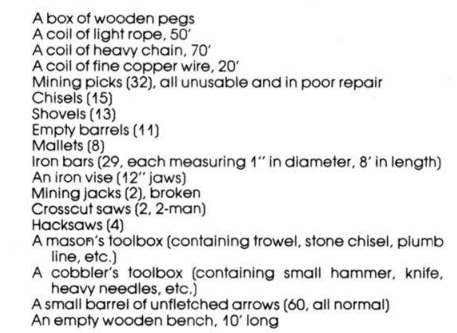

I know the conceit of the dungeon is that this is someone's home and stronghold but it kind of just feels like someone's Minecraft fort? I really feel like we're going to walk into a room full of chests contain 94 doors and 4,000 grass seeds any minute now. And I guess that food is 30 years old? The inscrutable letter codes make me long for a dAlphabet.
It feels kinda weird that fire beetles fell out of use. "Magic lightning bugs that infinitely fuel lanterns without igniting in swamp gas" is a super handy conceit.
We have a super classic portcullis trap with a elegant twist: because the lever to lift the trap is strength-based (sum of strength scores), it almost definitionally separates the squishies from the tanks. The downside is, unfortunately, that it's functionally a save or die trap despite not instantly killing you?

It's also really interesting how the fantasy of bending the bars went away. That used to be such a big thing in the superman tv show era. I have yet to have a modern player even consider it. Not surprising it stopped being in rulebooks though.
There is one of the regulation early DND troll traps, where a mapping party is to be intentionally tricked and given false descriptions because a doorway is also a teleporter. It is explained somewhat poorly, which is particularly unfortunate for a tutorial dungeon, but the jist is that once they pass through the doorway you should rotate your map and act like you haven't started describing rooms turned 90 degrees. Because early DND kind-of assumes the party moves as a blob while in dungeoncrawl mode, you can't get split up by this, despite the fact that "realistically" it would totally do that. A weird quirk of this description is that, I have no idea when they bold words. You think they're bolding for emphasis but it's acting like they're bolding keywords, but prior to this they only bold spell names and the bar-lifting. Afterward it's mostly spells and a sole keyword.

I'm getting mixed messages here. I get why it's here, but come on.
The coverart is a reference to a specific garden room which has overgrown in the wizard's absence. It is, ultimately, just a pretty room with a slight hazard if a random encounter happens there. "The room on the cover is inexplicable and unrelated to the rest of the dungeon" is funhouse-y behavior IMO, but the rest of the dungeon is a series of vaguely plausible rooms assembled in a maze-y way. Which is as good a segue as any to briefly talk about the overall layout.
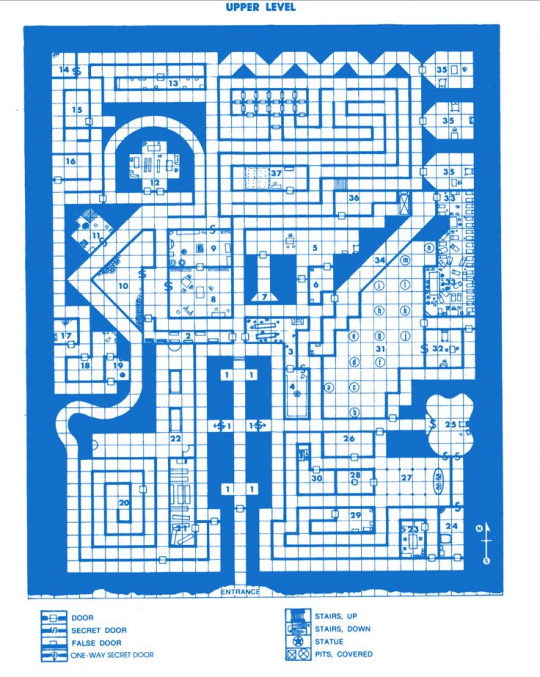
This is a bad layout. This is a layout you come up with when you are just procgenning maze dungeons over and over again. As we have demonstrated in previous posts, this is just kind of how it was in the 70s. This kind of works as a mapping challenge, but mostly it comes across as tedious for everyone involved. Who would make a living space like this? Even the most cooked adventurer on the planet would not install multiple maze corridors for…no reason? AND THE EXCESS OF SECRET DOORS. A friend described this as "a map you could almost make in Wolfenstein 3D", which is actually a great metric. If I can make your map in Wolf3D, it's bad.
There is a genre of dungeon room I like to call "gambler's traps", which is when the room contains like 10+ weird things that you can poke, and if you happen to poke the right ones you get some nice things, and if you poke the wrong ones you get pain. Invariably, you will have a player who tries to poke every one of them, offsetting the whole room. Pools of stuff are traditional, so we get pools. Tragically, every pool with a conceivably fun effect magically stops working outside the pool (come ON Carr!) and many are just pointless A few of them are totally devastating (one of them silences your voice for d6 hours), a few of them are slightly good. In what is a complete dick move, there is an acidic pool with a key at the bottom that does absolutely nothing.
Sigh you find the guy who advised the building of Quasqueton's room, with documents about the construction of it, but explicitly no information that could possibly help adventurers. One of the few magic items in this dungeon is locked in a drawer, but odds are it's nothing interesting (pray for your +1 Ring of Protection)
So the big maze corridor has a regulation spring-loaded trapdoor, which dumps you downstairs sans inventory into freezing cold water. Kinda mean but, sure. Traps are kind of an underrated artform, I feel like GMs as a group have just given up on them. That being said, traps like this one…do not sell me on traps as a concept.
Finally, we go to the lower level, which is not worth talking about in detail. Essentially, these egotists made a museum to themselves down here (for who?), there's a magic rock that if you eat it (??) has a d20 table of permanent effects skewing positive, and another pit trap. So, how to feel about B1 on the whole? It's not really remarkable. Really its most famous quality (you will key every single room) is its sole interesting quality. It's an early 70s dungeon that is starting to feel dated by 1979. I think that 5e-ers would benefit from a B1-like paint-by-numbers module, really. B1 is no Tower of Zenopus. I think we will all be much happier come B2, that (while far from perfect) has a strong identity and a comparative cohesiveness.
11 notes
·
View notes
Text
Small Update
The plan going forward is to take little breaks at the end of each year, to stave off burnout. We will see if I need to add half-years once they start really churning out modules. The next module, B1, will be out much later today (hopefully, it needs some revisions)). It kinda has Palace of the Vampire Queen energy? Cya then.
0 notes
Text
Yknow I filed this under Basic DND because the Halls of Mystery reads like a Basic module but It's not really any edition, it's one of those nebulous "works with DND" situations since it's not really interacting with any specific rules system. We can only speculate on what Turnbull was thinking at the time -- I would expect that that'd be Holmes Basic given he's over the ocean.
No. 7.5 - 1978 Reflections, and the Halls of Mystery
Welcome back to the end-of-the-year recaps! This is technically the first TSR iteration of it!
1. Coolest ideas
It's a lot of stuff from D2. The big ticket item is "neutral-ground hostile shrine" -- any time you can muck about with otherwise hostile people without drawing swords immediately is a big win. I know that the reaction table is supposed to mitigate that some but, cmon. Sometimes you just can't think of a good reason that the 9th goblin pack tonight is not immediately hostile. This is a way more natural way to handle it. And it lets you talk and such and experience their culture from their perspective!
2. Coolest Module You Haven't Heard Of
This is honestly a hard one because all of these modules are intensely well known. Gun to my head, I would probably vote for G1. The D-series is cool but frankly there have been more better and more interesting iterations of subterranean hexcrawls -- Veins of the Earth being the currently famous one. But the thing about G1 is, G1 is a surprisingly natural and fun location. Unlike the others in the GDQ series, G1 is genuinely an adventure you could slot anywhere with no context. It is simply a fun raid on a fortress, which I never get tired of. The twists of "they're piss drunk" and "there's a slave revolt in the basement" are really good (albeit in 2024 a little stale) twists on the classic raid-on-fortress formula.
3. The Growth of Module Design
Honestly 1978 represents a rather stagnant year for module design. The most innovative design feature I see is how D1-D3 feeds into one another in a much more naturalistic way than its predecessors, and all through that deeply useful combination of hexmap and random tables with a handful of pre-programmed setpieces. I am eager to see hexmap technology get much better going forward.
…
Surprisingly, 1978 wasn't too much to talk about? I don't generally think of Gary as an "innovator" in module design space. His main contribution is taking things that already exist and making them feel more natural. Which is not to say that I now buy into Gygaxian Naturalism as this great feat, more than a lot of his competition at the time was seemingly intentionally anti-Naturalism. Their work feels like the reaction to me, Gary is just staying the course of "this should make an amount of sense". Although, his random dungeon monsters mishmash still feels as nonsensical as all hell.
The Halls of Mystery (From Dragon 21, December 1978)
And as threatened, we're going to have a very brief section on The Halls of Mystery, which holds the dubious honor of 1st Dragon Magazine dungeon. I would throw the full header at you, but everything is by Don Turnbull. You may recognize his name, at publication time he works for Games Workshop and he will be heading up TSR, Inc.'s UK branch starting in 1980, leading to the much-beloved Fiend Folio.
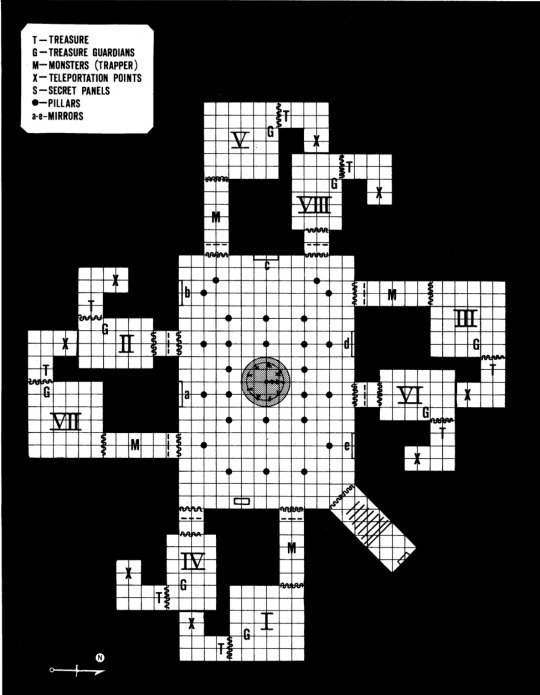
So. Not much to say about this, actually, It's a very large room with some branches. The main schtick of the Halls is that the main chamber contains several mirrors, some of which are magical. There's a big riddle on the desk on the south side, the riddle solution is actually quite obvious (say Excalibur three times -- and hey, Don told us the answer and rationale of the puzzle! Thanks Don!). When you move the central cylinder, it teleports you to the corresponding position in the dungeon. The rest is a lightweight stocking of the dungeon with monsters, treasure, et c. If you're keeping score, this is a Zelda puzzle. It's very cute and lightweight and honestly it's so neutrally written (no statistics are given and it would be trivially easy to restock it at any level) that you could genuinely use it in 2024 with very little effort. It's adorable! It is also wonderfully lean, clocking in at two total pages and frankly it's super refreshing to have such a light read of a module here.
Happily, next time we will be covering B1 - In Search of the Unknown, which is the second Basic D&D adventure we will be reviewing in this series (The adventure printed in the Basic rulebook, Tower of Zenopus, was first. This is our first lettered Basic adventure.) And, funnily, the first TSR module in this lineup I've never read before. See you then!
8 notes
·
View notes
Text
No. 7.5 - 1978 Reflections, and the Halls of Mystery
Welcome back to the end-of-the-year recaps! This is technically the first TSR iteration of it!
1. Coolest ideas
It's a lot of stuff from D2. The big ticket item is "neutral-ground hostile shrine" -- any time you can muck about with otherwise hostile people without drawing swords immediately is a big win. I know that the reaction table is supposed to mitigate that some but, cmon. Sometimes you just can't think of a good reason that the 9th goblin pack tonight is not immediately hostile. This is a way more natural way to handle it. And it lets you talk and such and experience their culture from their perspective!
2. Coolest Module You Haven't Heard Of
This is honestly a hard one because all of these modules are intensely well known. Gun to my head, I would probably vote for G1. The D-series is cool but frankly there have been more better and more interesting iterations of subterranean hexcrawls -- Veins of the Earth being the currently famous one. But the thing about G1 is, G1 is a surprisingly natural and fun location. Unlike the others in the GDQ series, G1 is genuinely an adventure you could slot anywhere with no context. It is simply a fun raid on a fortress, which I never get tired of. The twists of "they're piss drunk" and "there's a slave revolt in the basement" are really good (albeit in 2024 a little stale) twists on the classic raid-on-fortress formula.
3. The Growth of Module Design
Honestly 1978 represents a rather stagnant year for module design. The most innovative design feature I see is how D1-D3 feeds into one another in a much more naturalistic way than its predecessors, and all through that deeply useful combination of hexmap and random tables with a handful of pre-programmed setpieces. I am eager to see hexmap technology get much better going forward.
…
Surprisingly, 1978 wasn't too much to talk about? I don't generally think of Gary as an "innovator" in module design space. His main contribution is taking things that already exist and making them feel more natural. Which is not to say that I now buy into Gygaxian Naturalism as this great feat, more than a lot of his competition at the time was seemingly intentionally anti-Naturalism. Their work feels like the reaction to me, Gary is just staying the course of "this should make an amount of sense". Although, his random dungeon monsters mishmash still feels as nonsensical as all hell.
The Halls of Mystery (From Dragon 21, December 1978)
And as threatened, we're going to have a very brief section on The Halls of Mystery, which holds the dubious honor of 1st Dragon Magazine dungeon. I would throw the full header at you, but everything is by Don Turnbull. You may recognize his name, at publication time he works for Games Workshop and he will be heading up TSR, Inc.'s UK branch starting in 1980, leading to the much-beloved Fiend Folio.

So. Not much to say about this, actually, It's a very large room with some branches. The main schtick of the Halls is that the main chamber contains several mirrors, some of which are magical. There's a big riddle on the desk on the south side, the riddle solution is actually quite obvious (say Excalibur three times -- and hey, Don told us the answer and rationale of the puzzle! Thanks Don!). When you move the central cylinder, it teleports you to the corresponding position in the dungeon. The rest is a lightweight stocking of the dungeon with monsters, treasure, et c. If you're keeping score, this is a Zelda puzzle. It's very cute and lightweight and honestly it's so neutrally written (no statistics are given and it would be trivially easy to restock it at any level) that you could genuinely use it in 2024 with very little effort. It's adorable! It is also wonderfully lean, clocking in at two total pages and frankly it's super refreshing to have such a light read of a module here.
Happily, next time we will be covering B1 - In Search of the Unknown, which is the second Basic D&D adventure we will be reviewing in this series (The adventure printed in the Basic rulebook, Tower of Zenopus, was first. This is our first lettered Basic adventure.) And, funnily, the first TSR module in this lineup I've never read before. See you then!
8 notes
·
View notes
Text
No. 7 - S1, Tomb of Horrors (October 1978)
Author(s): Gary Gygax Artist(s): David C. Sutherland III (Cover), David Trampier Level range: 10-14 Theme: Meatgrinder Dungeoncrawl Major re-releases: So, so many. S1-4 Realms of Horror, Return to the Tomb of Horrors, Tomb of Horrors (2005), Tomb of Horrors (2010), S1-4 Dungeons of Dread, Dungeon #213, Tales from the Yawning Portal, Tomb of Annihilation (sort-of)
I said earlier that S1 is probably the only adventure more ported than G1, and I was right. You have so many options for S1. The original monochrome, the green cover, the compilation version, the silver anniversary version re-erlease-and-sequel, a 3.5e port, a 4e port, a DND Next port w/ 4e porting instructions, and then finally the 5e port in Tales from the Yawning Portal. The only people being left out here are the 2e people, and making 1e adventures go into 2e is as natural as breathing.
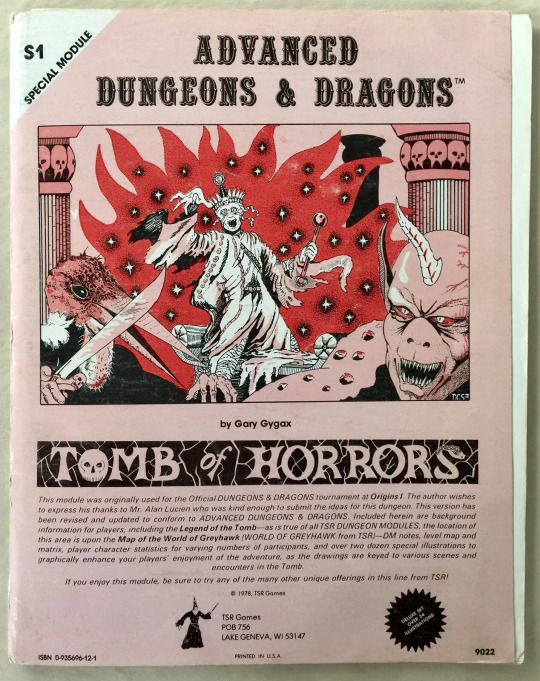
As the cover points out, this was originally run at Origins I, and there is so much community lore surrounding this module that I will spare you the rigamarole. If you know where I stand on the "meatgrinder vs fair challenge" argument, go read the Theme header again.
These illustrations are iconic. In basically every re-release they are kept as is, one of the few things that makes the 5e release stand out is not including the original 31 illustrations. And while the new art is OK, I, it can't hold a candle to the sheer charisma of the originals. And -- why no green devil head? That's the single most memorable thing from the scenario? We get one, actually, but it's on the map and I think it's an image from the archives because it looks an awful lot like an old cover of Dragon. If you do run this in 5e, you really owe it to your players to hunt down and use the original illustrations.
I am now morally obliged to tell you that, when I went through Tomb of Horrors (5e version, that's what I can find GMs for), I died to the Juggernaut. Which is actually extremely funny, because earlier when I was in Tomb of Annihilation I died the exact same way! So I guess Juggernauts are my personal arch nemesis. I personally didn't like my time there, but there is value in a module that everyone has played. I wouldn't've picked S1 for the task but I'm glad we have one at least. In general, this will be a a sparse entry in the series. The Tomb of Horrors is Tomb of Horrors. It is both extremely notable and also weirdly bland -- there's just not much to say about a lot of these trollish traps. They're highly specific and only really work in the moment, for very specific tables, at a very specific cultural moment. It's actually kind of boring to read in 2024? How much can one really say about a 20-colored mural with a variety of "it does nothing" effects?
Alright, enough stalling. The module starts with now-traditional Gary intro of "hey, your players are going to try and get extra information in [obvious way], defeat that." Today's edition is that Legend Lore is rendered useless by a combination of obscurity and….too much information? Ok… And then the also very Gary "If your players are dumb stupid idiots they will hate this module", which he also did in G1-3.

Eventually, your party finds this stupid looking thing, which is (I know this is repetitive) iconicly so-bad-its-good. And everything about this intro is trolling. So There are three routes into the tomb, two of which are trapped and fake. 2024 DND players would never think to try any of these things, but I do get the sense that in 1978 it would've occurred to most veteran players to try things like "poking the wall with sticks" and "extensive excavations". Anyone who tries to be clever and bypass shit by phasing into a parallel plane gets got by Demons, and I like the theory that Seth Skorkowsky aired a while ago that the Demons are the ones maintaining the Tomb so you should steal that.
You know what? Let's just go into keyed mode.
I do not respect this "only these express options work" mindset. It's very anti-ttrpg to have pre-programmed solutions Naturally, the second door cannot be removed by strength, only by one of 5 spells and thinking to wedge the door with iron in a specific day works. IDK bro I know the idea is Acererak is an asshole and has bewitched this complex to high hell but cmon, even the fake doors are borderline invulnerable?
There's a riddle-poem that hints at the solutions to the dungeon's puzzles. I actually really like this poem, and for all this module's sins I disagree with commenters who think the poem is too vague. At least when I was playing, it was just right.
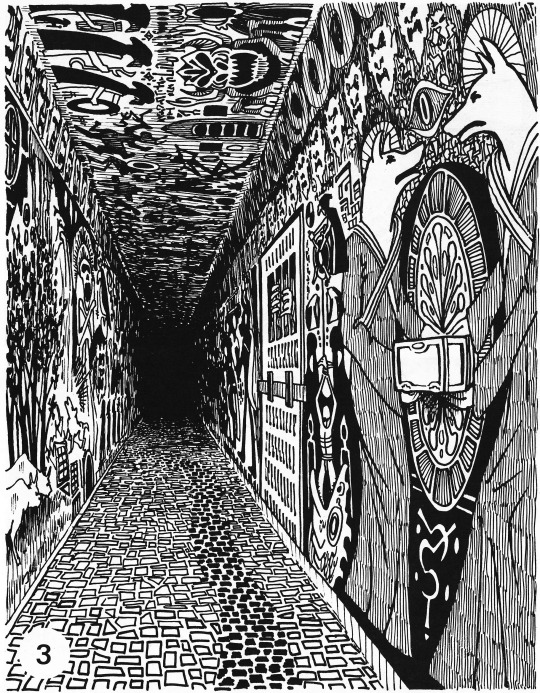
That is the most off brand Ancient Egyptian tomb hallway I ever did see, and I do kind of love it. As for how confusing the wall-door-chest trap is, it's trollish but it makes sense to me. The chest is a red herring to distract you from the actual secret door, which is a literal door, and honestly that's a hint I consider fairly on the nose.
The misty arch sucks. The short version is that if you press the glowing stones in the right order, you progress, otherwise you get teleported to one of three random rooms. The solution is inscrutable to me (why that order? you could brute force it but that'd be suicide) and I really wish that the book spelled out what the puzzle logic was -- a lot of newer adventures will explain the operating logic in parentheticals next to the solution. If the answer is "you're supposed to brute force it", I have no respect for that mindset.
The devilhead is obviously iconic as hell and we love it. As many commenters have noted, the often-cited "our whole party climbed in and died" story is incompatible with a RAW or RAI interpretation -- your GM was just an asshole, your character died as soon as their head got annihilated and the party would see their body go limp suddenly. There is no way all 5 of you piled in without removing a body and discovering they're Very Dead.
The lever room also sucks. You could only guess the solution, and the act of testing will get you killed. And don't give me "well your hirelings" your hirelings are not going to test any traps after they see the 2rd guy get turned into meatpaste, and while ADND lacks the hard cap on people hireable that Basic had, you're still going to run out of guys who are willing to commit suicide in here in short order.
"Yet there are also depicted various religious symbols of goad alignment, and a faint aura of good can be magically detected. What a puzzle! Could the demi-lich actually have been of good alignment" This will fool no-one Gary. It's the Tomb of Horrors, not the Tomb of Hope. He clearly bewitched the chapel to appear as good, which literally anyone would think of. Heartbreaking: worst lich you know has access to revolutionary SRS magic.
It's at about this point where I realized how little there really is to comment on in this dungeon. It really is just a sequence of obtuse murder traps that are faintly hinted at. The things that are iconic about it (the devilhead, the acerack fakeout) are actually exceptions to the rule -- both of those are super clear traps that are designed to tease particularly foolish players. The majority of the dungeon is, tap random objects and get gassed by poison or dropped into spikes. In a lot of ways ToH feels like the bad timeline version of White Plume Mountain, which is trollish in a more memorable way? What I mean here is, when people complain that ToH is unfair they're burying the lede. A hard dungeon can be fun. An unfair dungeon can be fun! The issue is that Tomb of Horrors is boring. Every room being a puzzle tied to a deathtrap with almost no combat or negotiation is tedious.
Basically every tomb of horrors room has this setup:
You walk into a room with an illustration that looks cool, and there is some vague image, object, or feature in the room that is conspicuous
There is either no obvious exit (strongly implying a secret), or an extremely obvious exit that is currently impassable
You have to try fiddling with any object in the room that can be fiddled with, or grope around for an illusion
There is a roughly 25% chance there is a vague hint from 3 gameplay hours ago that will help you if you interpret it correctly, and a 75% chance that this is intended as attrition
You fuck around for a while, and maybe you work out the puzzle and maybe you don't. Almost certainly, someone takes 50% damage or has some vital asset removed or changed about them.
You eventually pass into the next room
Really the variety of traps in this dungeon is surprisingly narrow -- something like half of these traps are "activate these objects in a specific order or orientation". The other half are some variety of mist or gas or cloud or other fluid that kills you if you do not avoid or interact with it in the specific way. Occasionally when you're lucky, you simply turn a lever and get skewered -- what a treat!
The final encounter with Acereak, you will be unsurprised to learn, also sucks. If you touch his jeweled skull, he instantly steals your soul and ruins your body (no save, no appeal). If you guess one of the, again, explicit list of options to destroy the skull (which you have already established will instantly kill one ally per touch) which is of course very specific (essentially, holy attacks, the most powerful magical swords, and inexplicably gem-slinging), you can kill him in 50 hp. Weirdly, the soul gems that you get trapped into do offer some escape from death, but it's a terrible one -- IF you pass your save, IF they crush the gem, IF there is an eligible body for their soul to go into (yours was ruined), then you may come back to life in a very different form. Completing the Tomb gives you, of course, 100k exp. And in ADND that'ssss…. actually not very much. At level 10, 100k exp is not even a full level for most classes to get a level (thieves are the exception) and your actual treasure haul I think is going to be fairly meager -- I think the average character will get maybe one level of experience after distributing the loot. For going through one of the most dangerous dungeons ever.

I remain a bit of a ToH hater.
In blog news, we are looking at post 7.5 coming up, in which I will do another retrospective on the year's developments, and as a special treat we will be briefly discussing the first Dragon Magazine dungeon!
11 notes
·
View notes
Text
No. 6 - D3, Vault of the Drow (August 1978)
Author(s): Gary Gygax Artist(s): David C. Sutherland III (Cover), David A. Trampier Level range: Average of 10, preferably party size 7+ players Theme: Underground exploration Major re-releases: GDQ1-7 Queen of the Spiders; Dragon #298 and #300 (kind of), Drow of the Underdark (even less so)
Fuck I love old module covers. Again the later revision (the blue one) changes the art to be less gloriously trash, which is a shame. The cartoony sketch era is not long for this world, C1 (Tamoachan) represents a pretty noticeable change in art style towards the kind of THIN YOUR PAINTS looking characters in color. We have another year of modules before they make the art less silly.
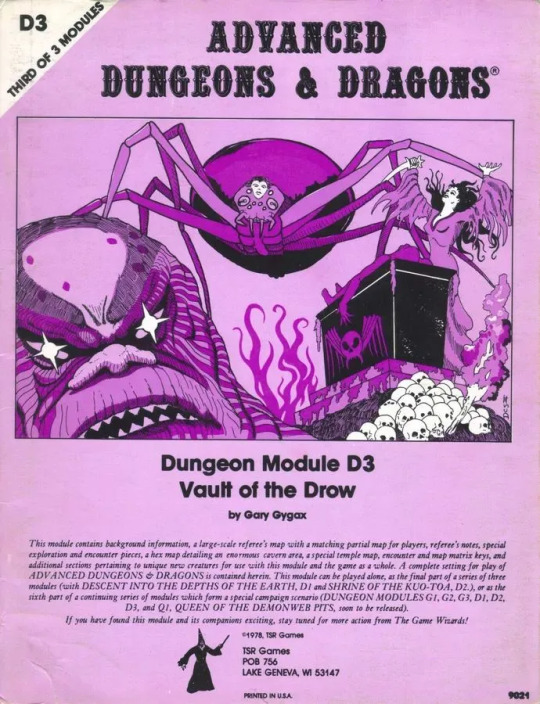
In re-release news, again we get a very lightly altered treatment in GDQ Queen of the Spiders. Less well known though is a section in Dragon #298 (immediately after Paizo took over) on the Vault of the Drow, although it is…almost entirely setting material, which makes it actually somewhat faithful to D3. What makes it unfaithful to D3 is that it takes place after the events of 1e/2e DND and doesn't contain any of the pre-Vault materials of D3 or the Egg of Lolth section.
Drow of the Underdark is a similar situation, but curiously uses totally distinct materials (like yet another map of the city), but contains even less information about the non-city parts of the Vault. Still, it's interesting seeing 3e-style treatments of D3, and if nothing else it gives you some damn visuals of what Erelhei-Cinlu actually looks like.

The module starts with a recap, and also a brief note as to how to get to the titular Vault of the Drow. Apparently you are now avowed nemeses to Drow, despite plenty of routes to the contrary. We'll also find out later that we're actually enemies to only one bloc of Erehlei-Cinlu Drow. We get the same list of warnings as the previous 2 modules, which themselves contained a lot of warnings from the G series, so this is our 6th time reading some of these bulletpoints. Strangely, apparently "because of the chaotic nature of the dark elves", active raiding parts of the town won't rouse organized resistance to the party, Light spells don't work right here (they go dark and brownish), and Drow resent even the slightest natural-ish light. The upshot is that you can get away with a lot of bullshit.
Our random encounter tables have been updated to reflect being past the main Depths foes of kuo-toa and the like, it's mostly Drows and monsters from this point on. Well, and undead. And bugbears. And trogs. And trolls. And slaves, of course. So mostly just that Kuo-Toa are gone? Svirfneblin are listed with the random encounters despite not actually being on the random encounter list? Anyway.
We have a few canned encounters.
The first one is, suspiciously similar to the Drow checkpoint in D1. It's basically the same. I'm not going to cover it again, it's just the D1 checkpoint but with the weird Battle of the Sexes angle removed.
The second one is a bizarre encounter -- a succubus is pretending to be a statue, a Drow vampire is glamored to look like a songbird, and the whole cavern is glamored to look like a beautiful grove. The vampire is, obviously, named Belugos, because fuck it why not name the vampire Bela Lugosi? They're gonna do their level best to make the players turn around without fighting, but the odds of the whole party failing the charm person AND not finding this suspicious is 0%. Their mesmerized gnome servant completes the Dracula reference.
It's passingly mentioned in their treasure notes that, Bela Lugosi lead-lined a box to hide magic items from magic detection. So that's our newest data point in the "we have to have rational explanations for magic" series.
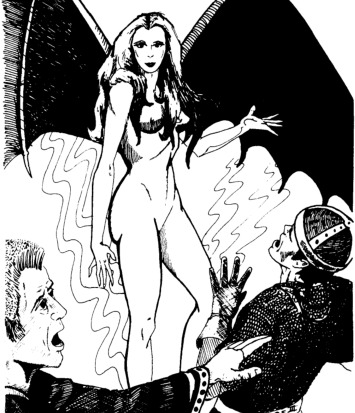
I guess she always goes nude. She's also nude on the revised edition back cover, which I'm sure got someone in trouble with their parents in 1985. This is one of your two possible routes into the Vault, by the way.
The other way is through a giant spider trap. The only thing of note is the idol of Lolth you can find that gives you a variety of neat powers (but slowly turns you into a giant spider).
In the vault proper, we have some fun special qualities. Everything is simply a different color here, for starters -- modified by your vision type. The ceiling is literally a kind of radioactive parody of the heavens, complete with "stars" and "moons" being played by particular types of rocks and lichens. Everything's got a vague red hue, except the roads which are enchanted to be lightly blue to drowish eyes -- that's what those magical glasses from a few modules ago do, they help you see drow-enchanted markers.
The place is lit with growing shrooms, for all the light that'll give you. A lot of the random encounters give us little glimpses into drowish life, from the lumberjacks clearing fungi for food, leather, et c., to drow nobles on a hunting party, to merchants feuding, to kuo-toan spies lurking in the river.. A good amount of love went into these tables, which I really wish was the norm. "There are bugbears, they have these items and this leader" is a pretty lame encounter good only for punishing slow moving. That being said, this adventure loosely implies Bugbears are Polish? What?
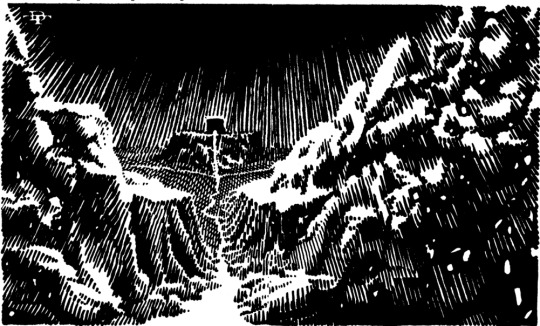
D3 is actually super sparse on artwork, and this is the best one we're going to get all module. This is the Black Tower, which overwatches a chokepoint to everywhere in and out of the Vault. If you have a drowish medallion, you can just saunter on in, enjoy your Evil Elf TSA checkpoint experience, then go about your business in the Vault. The medallions are coded by noble/merchant house, which means that your party just automatically became affiliated in a highly partisan city! Woe betide you, sucker that approached the tower openly hostile, cus they're guarding it with the GDQ series' perennial favorite: hand ballistae, and if you linger around the tower when the alarm goes off Gary straight up tells you to declare Rocks Fall, Everyone Dies because 300 drow troopss show up. Very cool, Gary!
So this is when D3 gets Complicated.
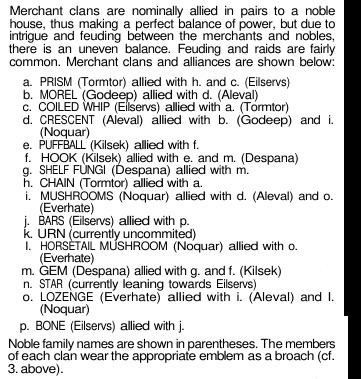
The best part of the Drow are is how much they plot. The worst part of the Drow is how much work that plotting is to run. 24 different families are all circling around each other, looking for weaknesses, allying and warring with one another. I think you would literally need multiple relationship maps to keep them all straight. The above list is actually only about two-thirds of the total relationships between houses, the rest come later with the noble house keys.
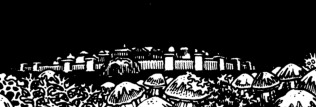
So, this tiny picture is the only visual we get of Erelhei-Cinlu. Well, that sucks. OK, well, let's presume you don't go in through the front gate, because that's obviously suicide, what then?

I'm sorry, what? The doors automatically sense your race and summon a demon with no ability to disarm? Fuck off, Gary. You have to go through the Black Tower. You have to get a medallion. You have to go through the Front Gate. You have to fight Lolth instead of the Elder Elemental God. Fine, I go through the front door.
E-C's description is exhausting to read because it's one of those times Gary just vents his orientalist, misogynist biases. Women are in charge? The men aren't buff?? There's sex workers??? Get me my fainting couch!
A lot of ink is spilled on the treatment of slaves, half-drow, non-drow, et c. Tragically the actual appearance of the city is not commented on very much beyond "it's very mazey" and "it's dark". E-C is perpetually 5 seconds from collapse at all times, but also hilariously stable. RIP to anyone dumb enough to rebel here.

Understandable.
E-C's section is a fairly rote "city that sucks" so let's move on.
Ah, the Noble Houses section. There is no way to put this gently, so let's rip the bandaid off. This is so much information that it's overwhelming (8 noble house houses with equipped npcs, special magic items, motivations, room counts, et c.) but also so little information about each individual house that you're going to have to heavily homebrew huge chunks of content.
For example, the first listed House is Tormtor. We know they're:
Rank 7 in the Nobility Hierarchy
They've bought off the head of the Male Fighters' Society.
Allied with Eliservs House, the unnamed Prism and Chain Clans, & indirectly to the unnamed Coiled Whip, Bars, Star, and Bone clans
They on the up and therefore unpopular with the other nobles
Have 6 unnamed nobles ruling the house
Have 6 named and 7 unnamed magic items.
But…what is special about this house? Why are they so ahead? What does their palace look like? Why would you go to it? How could you possibly interact with the alliance and enemy system, as a non-drow?
These descriptions are just not useful, and by the time you have written out enough information on all 24 families you have made the actual module into a footnote. Those later write-ups of E-C can't save you either, because the timeline advanced.
By reading the whole thing and taking notes you reveal that there are two blocs (the Tormtor-Eilservs bloc and the Despana-Kilsek-Noquarto bloc) and a handful of neutrals waiting for a clear winner to back.
The Eliservs are the first rank house, headed by Eclavdra, and their big plot was pivoting from Lolth worship to Elder Elemental God worship because the Lolth priestesshood didn't back Eclavdra's claim for Queenship. Remember Eclavdra? The text explicitly says that if she died in G3 she was cloned (eyeroll) by her consort. Why organize the events of the G series? To get more EEG converts and attain Queenship. An extremely risky plan that we will discover in T1-2 and A1-4 is more plotholes than plot.
Like,
Eclavdra's house is about to fall before you showed up.
She's in charge of the Giants
Eclavdra's fall would signal an end to the Giant incursions
There is no longer a reason to deal with the Giants
There is no longer a reason to deal with the Drow
There was no reason to do any of this
The EEG temple is actually the one from G3, so you've even already punished the Drow before D1 even started! And also, how exactly is that possible? The route to the G3 temple and the route to D1 are 51 miles apart?
I have read quite a few suggestions on how to un-fuck GDQ, and my personal preference is this:
Flip every House's religions, EEG to Lolth and vice-veras
The Giant plot is Lolth's, and Eclavdra's sister is acting for her
Regardless of G1-3, Eclavdra is about to win the secret war for Queenship via the Lolth cult.
A unified Erelhei-Cinlu is a threat and must be stopped
Anyway, having now shredded the politics in here, we move onto the dungeon-dungeon.
First, the Egg of Lolth, which is the broader Lolth zone in Erelhei-Cinlu. Yada yada yada spider sacrifices, orgies, et c. It's all very rote. The head priestess of the lesser temple (not the greater temple!) has a lot of money but not so much magical items -- a weird quirk of D1-3 is that there are basically no magical weapons, so your fighter is probably livid by now. Then, we enter the Great Fane of Lolth, which is to say the greater temple. And we will go into keyed mode:
The temple itself is pagoda-themed, in case you haven't guessed that the Drow are supposed to be vaguely China-themed yet. Naturally trying to climb around and not dungeoncrawl properly promptly punishes you by being suddenly attacked by a giant pile of gargoyles and shadows.
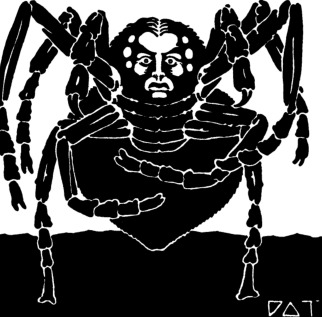
Every depiction of Lolth, even from this second-release copy I'm using, is just….truly sad. Why was "monster but animal head" so common for so long? It's not scary or weird or funny, it's just lame?
The walls are decorated with fake halloween spiderwebs, so this whole place feels like Spirit Halloween. The actual Fane itself is weirdly empty?
Like an evil confessional, all the council chambers have secret spying rooms.
You run into a fake Lolth illusion who pranks the party, which is really not helping the Spirit Halloween vibes
If you walk into a painting of the Demonweb Pits, you just instantly die (or skip directly to Q1 if your GM hates you -- general consensus is that Q1 is bad and that you should just use the pre-planned D3 version of the Lolth fight)
Finally, as you enter the dungeon part of the dungeon (which is actually pretty small by late-game dungeon standards), there is a passive fear aura and all the spiderwebs are now made of onyx and silver, which means your party is going to have a field day with the chisel.
To my great shock and happiness, there is a drow dissident here! And he's good! And won't backstab you! He is neutrally aligned and wants to reform drow society. Good for him! There's a messed up enchanted silver cage which essentially magically webs a victim in a sort of metaphorical representation of a true spider enwebbing their prey. It's a cool visual!
Lolth just kind of, hangs out in room D5. She isn't doing anything. If you kill her, she drops an egg with plot items for Q1, and geases you to walk through that one painting. No save, of course. Lolth herself is a "hard to hit, high resistances, low HP" affair, but also she can heal herself for 50% three times a day, so she is triple dipping on difficulty (in this biz we call this "deeply unsportsmanlike" but I'll give a pass for a demon queen being bullshit)
There's no real reason to go up. Lolth is down and you have no reason to believe good shit should be up, but if you do anyway you will find a variety of random people wandering around with magical goodies, like the high priestess and the commander. It's implied the priestess has been fucking a demon?
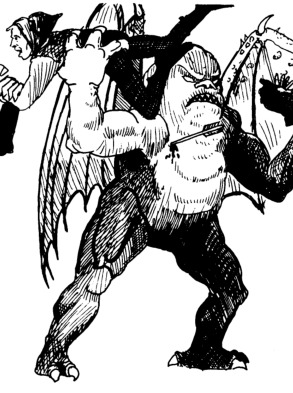
Your taste is a lot different than mine, ma'am.
Naturally the treasure room for the fane is hilariously trapped in like three different ways, including with permanent dust of disappearance. Inexplicably, there is a talisman of lawfulness that, if combined with some diamonds, tells you how to reach Lolth. Why was there a talisman of lawfulness in the treasury? Why does it tell you how to get to the demonweb pits? Why does it write in drowish runes?
Finally, you find a wharf with a boat in it. It's trapped with the previously mentioned sentient statue, but hey -- you now have a galley that you can only use on the Pitchy Flow, Svartjet, and Sunless Sea (in an unexplained way). Good luck with the 66 ghouls, 6 ghosts, and type 2 demon!
That's, that's it? Again, D3 reads like a tiny setting book larping with an obligatory dungeon at the end. The Fane is the blandest dungeon thusfar, and G2 was already pretty lame. Still, it is not lost on me that you could form an entire campaign in the Vault's materials, and it might even be good if you relax the "Drow are ontologically evil" quite a bit and allow your party into the factional fighting.
Next time, Tomb of Horrors! Possibly the most over-discussed module is actually a quite early one. See you then!
15 notes
·
View notes
